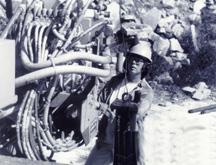Door County Environmental Council Column
- Share
- Tweet
- Pin
- Share

Dr. Maureen Muldoon, UW-Oshkosh associate professor of hydro and environmental geology, drilling into Door County dolomite limestone during her Ph.D. dissertation research. DCEC is sponsoring a program with Dr. Muldoon called “Threats to Your Groundwater” on Tuesday, September 16, 7 pm, at Crossroads at Big Creek in Sturgeon Bay.
Recently, many people have become concerned over the levels of nitrates in surface water supplies. Concern has been expressed that modern farming practices are contributing to the pollution of our state and nation’s drinking water, and some have gone so far as to suggest radical changes in farming techniques in hopes of solving the problem. However, an understanding of the relationship between agriculture and nitrates is necessary before reasonable decisions can be made.
Nearly all surface waters show a low level of nitrates throughout the year, and this has not yet been deemed a public health hazard. When nitrogen concentrations rise above 10 milligrams per liter, however, water suppliers are required to issue an alert, and steps are normally taken to minimize the exposure of at-risk individuals to these higher concentrations.
Elevated nitrate levels often occur in May and/or June when most agricultural fertilizers are applied. Concentrations normally peak and decline within a few days. The realistic problem facing the public with regard to surface water is how to minimize the frequency and severity of those peak concentrations that exceed 10 milligrams per liter.
The connection between agricultural activity and stream nitrate loadings cannot be denied. Elevated levels of nitrates have been noted in streams draining watersheds with high levels of corn or soybean production and high nitrogen fertilizer application.
Runoff from uncontained livestock operations is also a contributing factor. In the case of livestock operations, improved waste handling to minimize runoff can help significantly, but the situation regarding cropland is much more complex.
Studies have shown that most of the nitrates lost from crop fields move through subsurface flow rather than in surface water runoff. This indicates that direct loss of applied nitrogen fertilizer in surface runoff is not the major contributor to high nitrate levels in groundwater.
Nitrates in water are derived from three primary sources: rainfall, decomposition of soil organic matter, and nitrogen amendments (fertilizers, manures, etc.). Ideally, most of the nitrates in soil are absorbed by the harvested crop. Problems occur when the crop does not remove sufficient nitrates and the excess is flushed into streams after harvest, or when no growing roots are present to intercept it as it moves toward the stream.
The solution to the excess nitrates problem involves developing cropping systems that remove the nitrates added to, or produced within a given field in a given year. Some farmers choose a yield goal and then add adequate fertilizer nitrogen to supplement the amount normally released from the organic matter, to achieve the desired yield goal. The relatively dry summers which Wisconsin has experienced in recent years have reduced removal by crops, contributing significantly to the nitrate problems seen in the past several springs in many areas.
It is unlikely that nitrate peaks can be eliminated completely, because farmers must make their fertilizer decisions with no knowledge of what type of growing season will develop. There are, however, management strategies which may assist the farmer in reducing this problem.
Fertilizing for a realistic yield goal is one method. Yield is determined by the total crop production management system, not nitrogen alone. If the remainder of the production system limits production capacity to 130 bushels per acre, adding additional nitrogen to produce 170 bushels is not only detrimental to the environment but is also expensive.
Management programs should be improved, where necessary, to better utilize the fertilizer applied, or fertilizer rates should be reduced to coincide with anticipated yields.
In addition, farmers can adopt side dressing programs in which most of the nitrogen fertilizer is applied after the crop emerges. It is easier to determine potential yield once planting date and plant stand have been established. This approach can aid in developing nitrogen rates for potential yields and should reduce accumulations of excess nitrate.
Fortunately, such management options may reduce the cost of production for farmers, as well as reduce the quantities of nitrates potentially available to enter streams.
If you suspect there may be nitrates in your private water source beyond the limit 10 ppm (milligrams per liter) at any time during the year, take a water sample and bring it to one of the farm events where free testing is done. Or, contact your local reliable plumbing contractor or Analytichem Lab in Luxemburg (Dykesville), N9190 Bay Meadow Lane, at 920.866.3955, which will test for nitrates and bacteria for $45).
